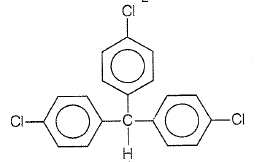The reagent used for the separation of acetaldehyde from acetophenone is:
1. NaHSO3
2. C6H5NHNH2
3. NH2OH
4. NaOH and I2
The major organic product formed from the following reaction

| 1. |  |
| 2. |  |
| 3. |  |
| 4. |  |
1.
2.
3.
4.
A and B in the following reactions are 


1. A=, B=NaOH
2. A=
3. A=
4. A=
| 1. |  |
| 2. |  |
| 3. |  |
| 4. |  |
Trichloroacetaldehyde, CCl3CHO reacts with chlorobenzene in the presence of sulphuric acid and produces
| 1. |  |
| 2. |  |
| 3. |  |
| 4. |  |
1. 
2. 
3. 
4. 
Lacrymator or tear gas is:
1. C6H5COCl
2. C6H5OC6H5
3. C6H5COCH2Cl
4. C6H5COCH3
Formaldehyde can be distinguished from acetaldehyde by:
1. Fehling's solution
2. Schiff's reagent
3. Ammonia
4. Ammoniacal
Compound (A) C5H10O forms a phenyl hydrazone and gives negative Tollen's and iodoform tests. Compound (A) on reduction gives n-pentane. Compound (A) is:
1. a primary alcohol
2. an aldehyde
3. a ketone
4. a secondary alcohol
Which of the following has most acidic proton?
1. CH3COCH3
2. (CH3)2C=CH2
3. CH3COCH2COCH3
4. (CH3.CO)3CH
Muscone (an explosive perfume secreted by musk deer) has the structure

. Its IUPAC name is:
1. 3-methyl cyclopentadecanone
2. methyl cyclopentadecan-3-one
3. 3-methyl cyclotetradecanone
4. 3-methyl cyclohexadecan-3-one
For the reaction:

Which reagent will be appropriate for the above conversion?
1. Zn-Hg/HCl
2. NH2-NH2/OH-
3. LiAlH4/H
4. HI/P
In the following reaction:
The structure of the major product 'X' is
(1)
(2)
(3)
(4)

1.
2.
3.
4.

Product is
1.
2.
3.
4.

1.
2.
3.
4.
Which shows decarboxylation by heating
1.
2.
3.
4.
Consider the following reaction,

Product is?
| 1. |  |
2. |  |
| 3. |  |
4. |  |
In the reaction

The oxidizing agent can be
1. alkaline KMnO4
2. acidified K2Cr2O7
3. benedict's solution
4. All of the above
Why does the reaction produce stable salt?
Because
1. In 'A' the ring is aromatic
2. 6 p electrons are present
3. Ring in a is stabilized by closed-loop conjugation
4. All of these
The major product of reaction
| (1) |  |
| (2) |  |
| (3) |  |
| (4) |  |
X, Y both responds to FeCl3 test and 2, 4 DNP test. One is thermodynamically controlled product (TCP) and another is kinetically controlled product (KCP). KCP is
| (1) |  |
| (2) | |
| (3) |  |
| (4) | All of these |
The product(s) Z is
| (1) |  |
| (2) |  |
| (3) |  |
| (4) |  |
In the below reaction, product 'P' is:
| 1. |  |
2. |  |
| 3. |  |
4. |  |